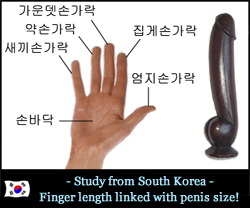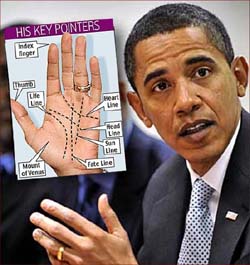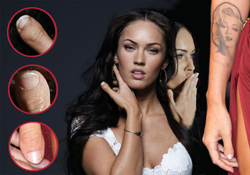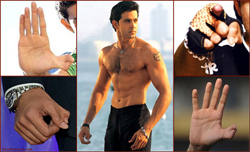Do you have a radial loop fingerprint?
August 5, 2013
 Do you have a radial loop fingerprint? In people who have radial loop fingerprints these are usually spotted on the index finger(s); in the field of hand reading it is a common beliew to associate radial loops with ‘people who do not go with the flow’ – refering to the fact that the radial loop represents sort of the opposite of the much more common ulnar loops. But what are the facts and how do they develop?
Do you have a radial loop fingerprint? In people who have radial loop fingerprints these are usually spotted on the index finger(s); in the field of hand reading it is a common beliew to associate radial loops with ‘people who do not go with the flow’ – refering to the fact that the radial loop represents sort of the opposite of the much more common ulnar loops. But what are the facts and how do they develop?
The latest research points out that a radial loops might have a connection with the Big Five personality dimension Extraverion (see picture below).
This article presents 10 facts about radial loops:
http://www.handresearch.com/news/10-facts-about-radial-loop-fingerprints.htm

Is your learning ability hidden in your fingerprints? – A CNN report!
November 24, 2012
In 2011 CNN made a report about ‘Wonderful Minds’ – a company in Singapore that uses dermatoglyphics to assess learning ability style of little children in order to provide a ‘guide’ to parents.
A thorough discussion of this technique – better known as: ‘Dermatoglyphic Multiple Intelligence Test’ or DMIT – is available at the Modern Hand Reading Forum.
Let us know what you think about this ‘service’!
Dermatoglyphics describe the origins of populations in China!
November 17, 2012
 Zhang Haiguo, an expert in dermatoglyphics, has earlier this month been awarded the Lifetime Achievement Prize for Anthropology by The Shanghai Anthropological Association.
Zhang Haiguo, an expert in dermatoglyphics, has earlier this month been awarded the Lifetime Achievement Prize for Anthropology by The Shanghai Anthropological Association.
The 62-year-old native from Shanghai became e.g. known for collecting dermatoglyphic variables from China’s 56 ethnic groups in an attempt to trace their origins and migratory route over a period of 30 years. Zhang Haiguo’s team has collected more than 150 samples by surveying more than 68,000 Chinese from all 56 ethnic groups – his study became known as the world’s first research of dermatoglyphic variables involving all ethnic groups of a country.
Zhang Haiguo has divided the ethnic groups into north and south groups. The research presents some surprising discoveries. For example, Tibetans’ origins could be traced from the very north of China, instead of India as popularly believed.
Zhang Gaoshan ethnic group, a community in Taiwan, was found to have originated from the Chinese mainland instead of from the islands of the South Pacific regions.
The professor says the research will also help in the study of some genetic diseases like Down’s syndrome. Based on his research, Zhang concludes that the disease will happen to one of every 690 Chinese people.
 Zhang says he is currently exploring a new research method, which combines generic and dermatoglyphic research in a bid to better decipher the origins of ethnic groups.
Zhang says he is currently exploring a new research method, which combines generic and dermatoglyphic research in a bid to better decipher the origins of ethnic groups.
“Which section of DNA decides people’s fingerprints? It has been a dilemma for scientists around the world, and I hope my years of study can shed some light,” he says.
Palm Reading?
When asked about his opinion on telling one’s fortune through palm reading, he says:
“I have perhaps seen more palms than most fortune tellers. But I don’t think someone can tell others’ fortune through palms. Someone invited me to join fortune telling 20 years ago, but I refused.”
Haiguo is currently a professor from the School of Life Sciences in Fudan University and a former associate professor from the department of medical genetics in Shanghai Jiaotong University’s School of Medicine. Zhang has published more than 70 articles and six books on dermatoglyphics. But his latest findings are compiled in a book, Dermatoglyphics of China’s 56 Ethnic Groups, which was published in July. His research data has also been published on PLoS ONE, an international peer-reviewed online publication of the US Public Library of Science.
Via: ChinaDaily.com
Born without fingerprints: ‘adermatoglyphia’ is caused by a gene!
September 20, 2011

Most of us have fingerprints, but some people are born with missing fingerprints. Only four families around the world are known to have been born with this disorder – a disease called ‘adermatoglyphia’. Recently dermatologists have found adermatoglyphia in a Swiss family – 9 out of 16 members have no fingerprints – is caused by a smaller version of a gene called SMARCAD1!
Almost every person is born with fingerprints, and everyone’s are unique. In an effort to find the cause of the disease, dermatologist Eli Sprecher sequenced the DNA of 16 members of one family with adermatoglyphia in Switzerland. Seven had normal fingerprints, and the other nine did not. After investigating a number of genes to find evidence of mutation, the researchers came up empty-handed—until a grad student finally found the culprit, a smaller version of a gene called SMARCAD1
The larger SMARCAD1 is expressed throughout the body, but the smaller form acts only on the skin. Sure enough, the nine family members with no fingerprints had mutations in that gene.
Being born without fingerprints doesn’t occur simply because one gene has been turned on or off, Sprecher said. Rather, the mutation causes copies of the SMARCAD1 gene to be unstable.
Full story about missing fingerprints in a Swiss family:
Missing fingerprints in a Swiss family caused by SMARCAD1 gene!
How to Use Hands in Building Relationships!
June 25, 2011
 As a research scientist, Dr. Erina Lee is responsible for the international relationships research at eHarmony. In the following article she described how to use hands in building relationships!
As a research scientist, Dr. Erina Lee is responsible for the international relationships research at eHarmony. In the following article she described how to use hands in building relationships!
Whether they’re soft and manicured, strong and calloused, weathered and wrinkled—hands come in all shapes and sizes and can often say a lot about you. They can reveal the tattered fingernails of nervous nail biter, the orange fingers of a cheese puff lover, or the worn hands of a grandmother. And when you look even closer at the many lines and wrinkles, is it possible that your hands can reveal even more? Some people believe that clues to our basic selves can be found in the details of our hands. But do our hands really tell us anything of importance about who we really are? Is it possible that the numerous bumps and ridges unique to every hand hold some insight into our level of intelligence or into our love lives?
In an eternal quest for self-discovery, people have looked towards hand readers, among other mystics, to see if the lines in their hands really tell them something meaningful about themselves and their future. In current times, people turn to internet quizzes and online hand reading to make sense of the heart and life lines and the shape of their hands. Although these tests and quizes can be fun, when put to the test of empirical science, most of these claims and predictions cannot be verified. Furthermore, these uncorroborated predictions about personality traits and future events leave palm reading in the category of a pseudoscience.
 Despite the inaccuracy of palmistry readings, however, there are aspects of the hands that have been studied empirically, including finger length. When looking at the palm of your hand, fingers straight together, you will likely notice a difference between your second (index) and fourth (ring) fingers. On average women have longer index fingers, compared to ring fingers while men have longer ring fingers compared to index fingers. This association between the two fingers, called the 2D:4D ratio, is related to levels of androgen exposure (a sex hormone higher in men) in the womb. That means that the amount of male hormones a fetus is exposed to determines this very specific detail of finger length in the hands. The precise mechanism by which androgen works is not entirely clear, but in general most theorists believe that increasing androgen exposure will masculinize a fetus. There is also some evidence suggesting that either too much or too little androgen can be feminizing to the fetus.
Despite the inaccuracy of palmistry readings, however, there are aspects of the hands that have been studied empirically, including finger length. When looking at the palm of your hand, fingers straight together, you will likely notice a difference between your second (index) and fourth (ring) fingers. On average women have longer index fingers, compared to ring fingers while men have longer ring fingers compared to index fingers. This association between the two fingers, called the 2D:4D ratio, is related to levels of androgen exposure (a sex hormone higher in men) in the womb. That means that the amount of male hormones a fetus is exposed to determines this very specific detail of finger length in the hands. The precise mechanism by which androgen works is not entirely clear, but in general most theorists believe that increasing androgen exposure will masculinize a fetus. There is also some evidence suggesting that either too much or too little androgen can be feminizing to the fetus.
Because androgen exposure is related to sexual development and masculinization, researchers have begun to wonder if the 2D:4D ratio, as a marker of hormone exposure, may also predict other characteristics. Hormone exposure has been linked to things like general physical health, cognitive abilities, personality, job preferences, attractiveness, and sexual orientation. While the 2D:4D ratio may relate to these developmental characteristics, thus far the evidence supporting such a link is at best described as mixed. For example, there has been much attention dedicated to whether the 2D:4D ratio relates to sexual orientation. While there have been several studies in this area, some have shown no differences between heterosexual and homosexual men in their 2D:4D ratios (e.g., Williams et al., 2000), and others, like Lippa, have shown heterosexual men having lower 2D:4D ratios compared to homosexual men. Similarly with other characteristics like personality and attraction, the research findings have been fairly inconsistent.
 Another aspect of the hands that have been conclusively studied are the ridges, the ones that cover the palms and fingers, the ones that make up our unique fingerprints. The study of these ridges is called dermatoglyphics. Similar to the finger length, these ridges are known to be established earlier in the embryonic development, while the fetus is still in the womb. Researchers have shown dermatoglyphic differences between non-deficient people and those with cognitive or genetic abnormalities, like schizophrenia, Down’s syndrome, and intellectual disability. For example, individuals diagnosed with schizophrenia show fewer ridges between two specific points under the second and third fingers [a-b ridge count] compared to non-schizophrenic controls (Bramon et al., 2005). These findings support the idea that changes in the prenatal environment can display its effects in multiple ways, including changes in cognitive development and ridges of the hands. However, the findings do not assume that all people with fewer ridges have cognitive deficiencies.
Another aspect of the hands that have been conclusively studied are the ridges, the ones that cover the palms and fingers, the ones that make up our unique fingerprints. The study of these ridges is called dermatoglyphics. Similar to the finger length, these ridges are known to be established earlier in the embryonic development, while the fetus is still in the womb. Researchers have shown dermatoglyphic differences between non-deficient people and those with cognitive or genetic abnormalities, like schizophrenia, Down’s syndrome, and intellectual disability. For example, individuals diagnosed with schizophrenia show fewer ridges between two specific points under the second and third fingers [a-b ridge count] compared to non-schizophrenic controls (Bramon et al., 2005). These findings support the idea that changes in the prenatal environment can display its effects in multiple ways, including changes in cognitive development and ridges of the hands. However, the findings do not assume that all people with fewer ridges have cognitive deficiencies.
To summarize, we do know that specific details in our hands are affected by early hormonal exposure and other environmental influences in the womb. And we know that this early exposure also affects other aspects of our development. While it is intriguing to speculate further that details in our hands can predict aspects of our personality or behavior, these conjectures have not been empirically supported. It’s also likely that there are more direct measures of personality, intelligence, and behavioral traits rather than the hands. But even though you can’t currently rely on your hands to unlock all of your mysteries, one thing you can count on is more studies and discussion about them to come.

What discriminates ‘Multi-Perspective Palm Reading’ from all other approaches in the field of hand reading?
Multi-Perspective Palm Reading is a new type of hand reading that is rising from scientific research reports that relate to the hand as a ‘diagnostic tool’. The unique characteristic of this advanced type of palm reading is that it only includes hand markers which have been confirmed to have significant value according scientific studies. So this NEXT NATURE variant of ‘palmistry’ is not connected anyhow with astrology nor any other philosophic system.
In Multi-Perspective Palm Reading is the hand studied from 7 different perspectives in order to make an assessment for various specified themes – which can result in either a confirming- or prognostic ‘hand-diagnosis’.
The philosophy behind Multi-Perspective Palm Reading:
The philosophy behind this new advanced type of hand reading can be described as follows:
“In Multi-Perspective Palm Reading, a reliable hand-diagnosis is only possible when a pair of hands displays ‘diagnostic clues’ in MULTIPLE perspectives of the hand. According Multi-Perspective Palm Reading a person typically requires to have ‘diagnostic clues’ in at least 3 perspectives of his/her hands, before one can speak of a solid, specified hand-diagnosis.
The application of this philosophy in the practice for making a hand assessment can be understood by studying the role of the simian line in hand diagnostics. In the 20th century the simian line (the most well known of all palm line variations: a.k.a. the single palmar transverse crease or simian crease) became known as a diagnostic marker for Down syndrome. However, during the past decades this uncommon hand marker was recognized as a ‘minor physical anomaly’ that has diagnostic value for other syndromes, diseases & developmental problems. But in order to specify it’s significance as a major hand line for the individual that has this characteristic in one or both hands, a study of the other perspectives of the hand is required!
The 7 perspectives used in Multi-Perspective Palm Reading:
In the following seven perspectives are required to be studied in order to make a thorough hand assessment:
1 – Palm Reading & the HAND SHAPE, including e.g.: hand index, palm shape, hand length, hand breath.
2 – Palm Reading & the FINGERNAILS, including e.g.: color, morphology, structure, growth.
3 – Palm Reading & FINGER MORPHOLOGY, including e.g.: finger length, 2D:4D ratio, variations in shape & width.
4 – Palm Reading & the MAJOR LINES, including e.g.: primary creases, secundary creases, tertairy creases & accessory lines.
5 – Palm Reading & the DERMATOGLYPHICS, including e.g.: fingerprints, palmar dermatoglyphics.
6 – Palm Reading & SKIN QUALITY, including e.g.: colour, structure, flexure / tone.
7 – Palm Reading & HAND MOTORICS, including e.g.: flexibility, motoric hand index.
Read more about how Multi-Perspective Palm Reading varies from other types of hand reading & modern palmistry via the Wikipedia section: Modern Palmistry: science & criticism

Many people sometimes wonder about the function of their ‘fingerprints’. Why do we have them? The answer is foundstarts in the sweat pores!
Discover 20 skin-facts you didn’t know – including hands, fingerprints & dermatoglyphics!


Grauman's Chinese Theatre handprints
A large collection of celebrity handprints is available at Hollywood Boulevard in Grauman’s Chinese Theatre.
Since 1927 this theatre has been drawing crowds in Hollywood with their unusual handprint collection. Over four million tourists flock to the location each year. The Walk of Fame stars passes right in front (see the first photo below), and the famed forecourt features handprints from stars ranging from Sophia Loren (see photo above) and Doris Day (see 2nd photo below) to Brad Pitt & Arnold Schwarzenegger. Just be prepared to rub elbows with other onlookers, as the entrance can get awfully crowded.
STARS INCLUDED (1927-2010):
– A few of the males are: Nicolas Cage, George Clooney, Sean Connery (James Bond), Matt Damon, Johnny Depp, Robert Duvall, Morgan Freeman, Tom Hanks, Eddie Murphy, Al Pacino, Brad Pitt, Daniel Radcliffe (Harry Potter), Arnold Schwarzenegger, Christopher Walken, Denzel Washington, and so many more;
– A few of the females are: Julie Andrews, Cher, Doris Day, Rhonda Fleming, Whoopi Goldberg, Sherry Lansing, Sophia Loren, Ali McGraw, Marilyn Monroe, Debbie Reynolds, Susan Saradon, Meryl Streep, Elizabeth Taylor, Emma Watson, and so many more.
An overview of the 200+ stars is available at Wikipedia.
Find more examples of celebrity hands & handprints:
MOVIESTARS HANDS – ARTISTS HANDS – MUSICIANS HANDS
SPORTS LEGENDS HANDS – POLITICIANS HANDS



Doris Day’s handprint was made in 1961.
HANDS & IQ – How to recognize a smart hand: 2 – the AtD-angle!
January 18, 2011
Most people are aware that they have fingerprints. But few people are aware of the likewise dermatoglyphic features in their palms. One of the most interesting characteristics of the palmar dermatoglyphics concerns the so-called AtD-angle: which concerns the angle between the a- triradius (under the index finger), the axial triradius (near the wrist), and the d-triradius (under the pinky finger).
 Interestingly, beyond the trisomy studies, a few other studies have indicated that the AtD-angle provides a significant clue about intelligence.
Interestingly, beyond the trisomy studies, a few other studies have indicated that the AtD-angle provides a significant clue about intelligence.A 2010 STUDY:
A 1980 STUDY:

In 1983 American developmental psychologist Dr. Howard Gardner argued that the concept of intelligence as traditionally defined in psychometrics (IQ tests) does not sufficiently describe the wide variety of cognitive abilities humans display. His theory became know under the name ‘Multiple Intelligence’ (MI). A few years ago a rather remarkable commercial spin-off from Gardner’s theory became available: a product named the DMIT, which stands for: ‘Dermatoglyphics Multiple Intelligence Test’.
The origins of the DMIT test were developed in Taiwan, and became available in various Asian countries as a franchise product. The product claims to be a scientific product focussed on assessing the ‘multiple intelligences’ of young children. Basically, the product suggests that one can assess Gardner’s multiple intelligences via the 10 fingerprints of your hand. And the assumption is made that each finger is connected with the 5 brain lobes of the hemispheres (see the picture below).


Is the DMIT a valid test?
So far there appears to be no public research available to answer this question – though an intelligent reader could recognize from this point solely a clue about the nature of this so-called ‘scientific test’.
By the way, Gardner’s theory describes only eight basic types of intelligence to date – though without claiming that this is a complete list. Gardner’s original list included only seven of these, but in 1999 he added a naturalist intelligence. He has also considered existential intelligence and moral intelligence, but does not find sufficient evidence for these based upon his articulated criteria.
Howard Garnder’s ‘multiple intelligences’:
More detailed considerations + links to GeneCode & ThumbRule DMIT websites are available at the Modern Hand Reading Forum:
IQ TEST: Does your intelligence correlate with your fingerprints & dermatoglyphics?



 Finger length & penis size linked!
Finger length & penis size linked! The hands of Barack Obama
The hands of Barack Obama Megan Fox thumbs – TRIBUTE
Megan Fox thumbs – TRIBUTE Hrithik Roshan thumbs – TRIBUTE
Hrithik Roshan thumbs – TRIBUTE Hand Reading Research!
Hand Reading Research! MultiPerspective Palm Reading
MultiPerspective Palm Reading